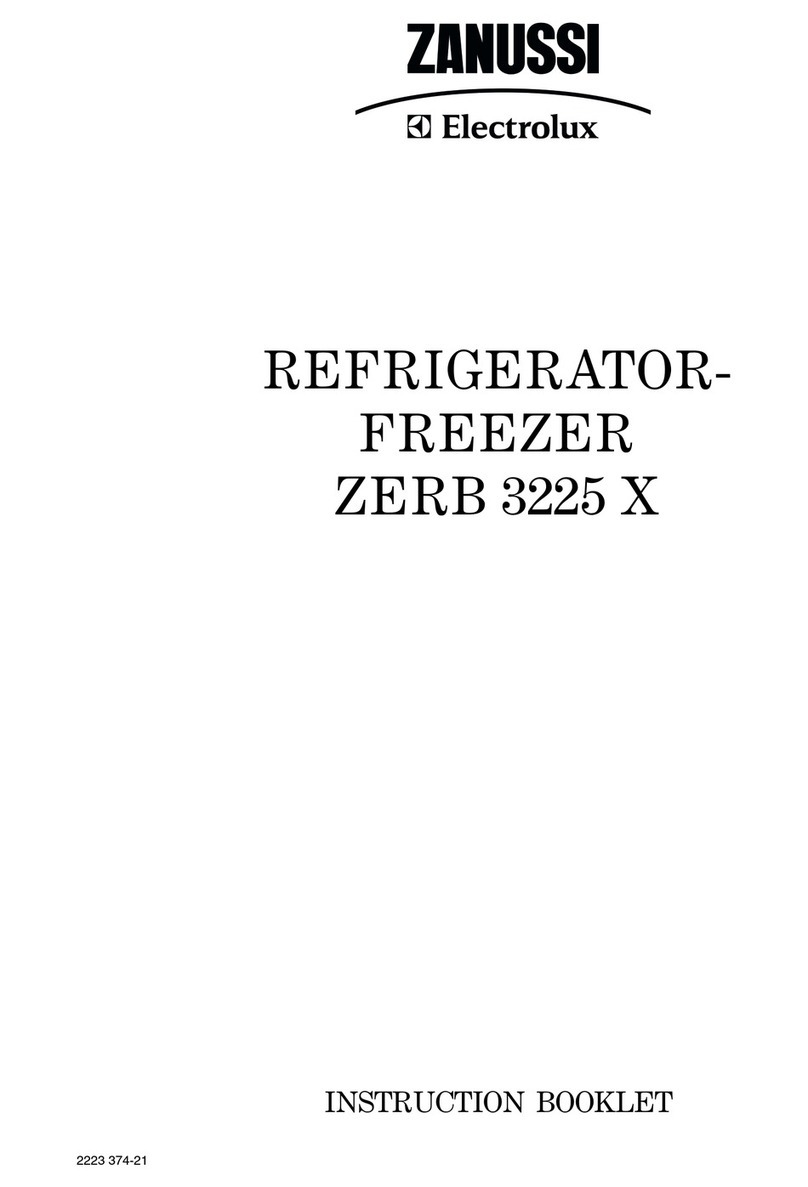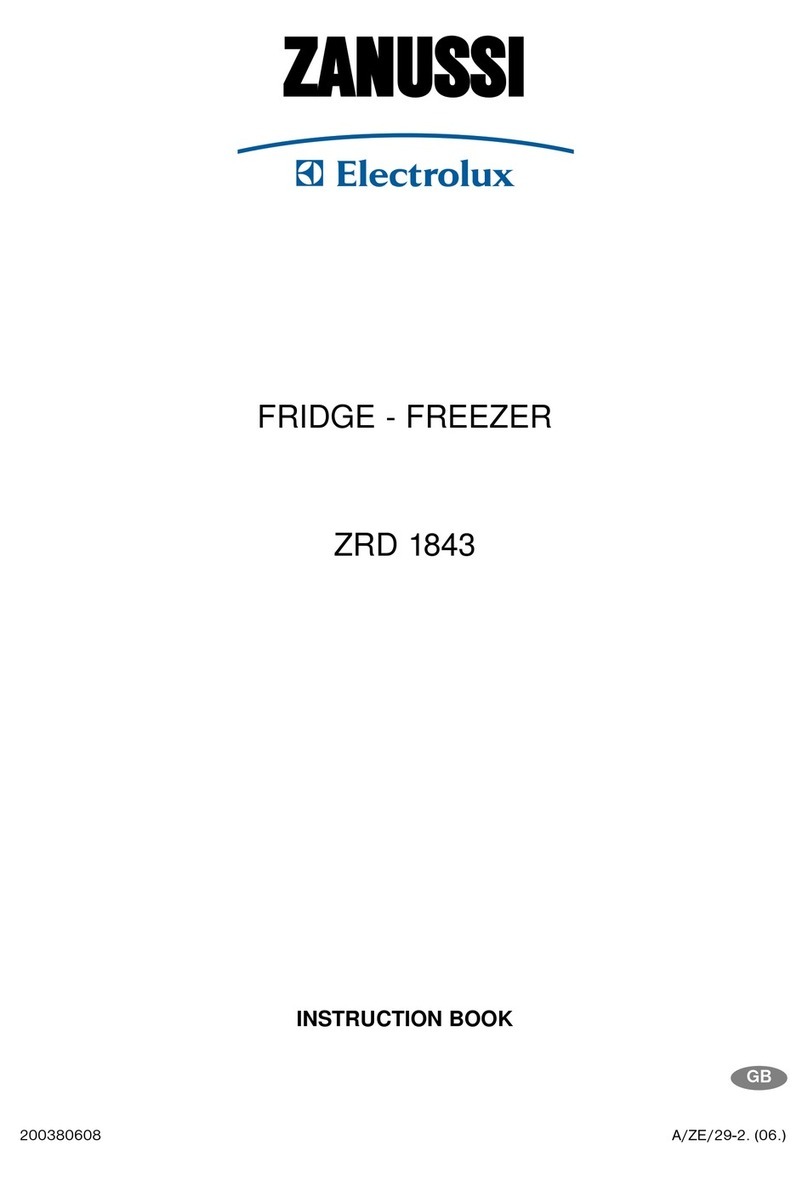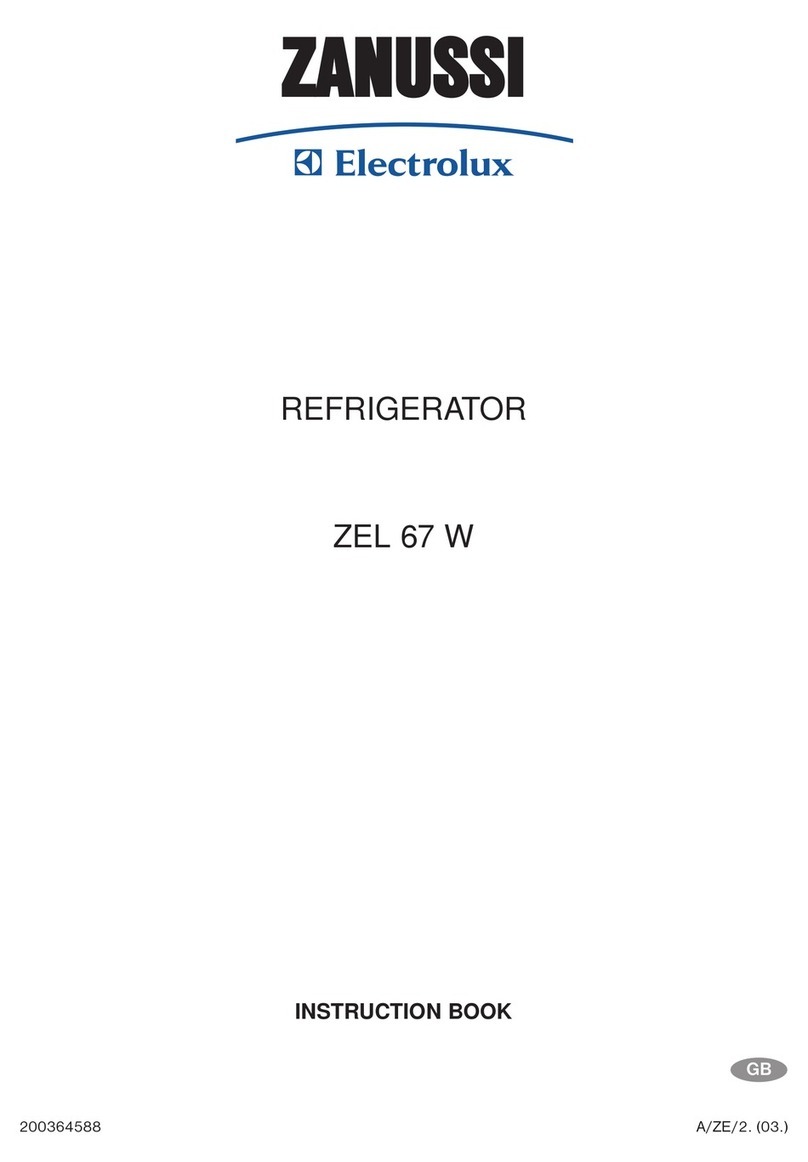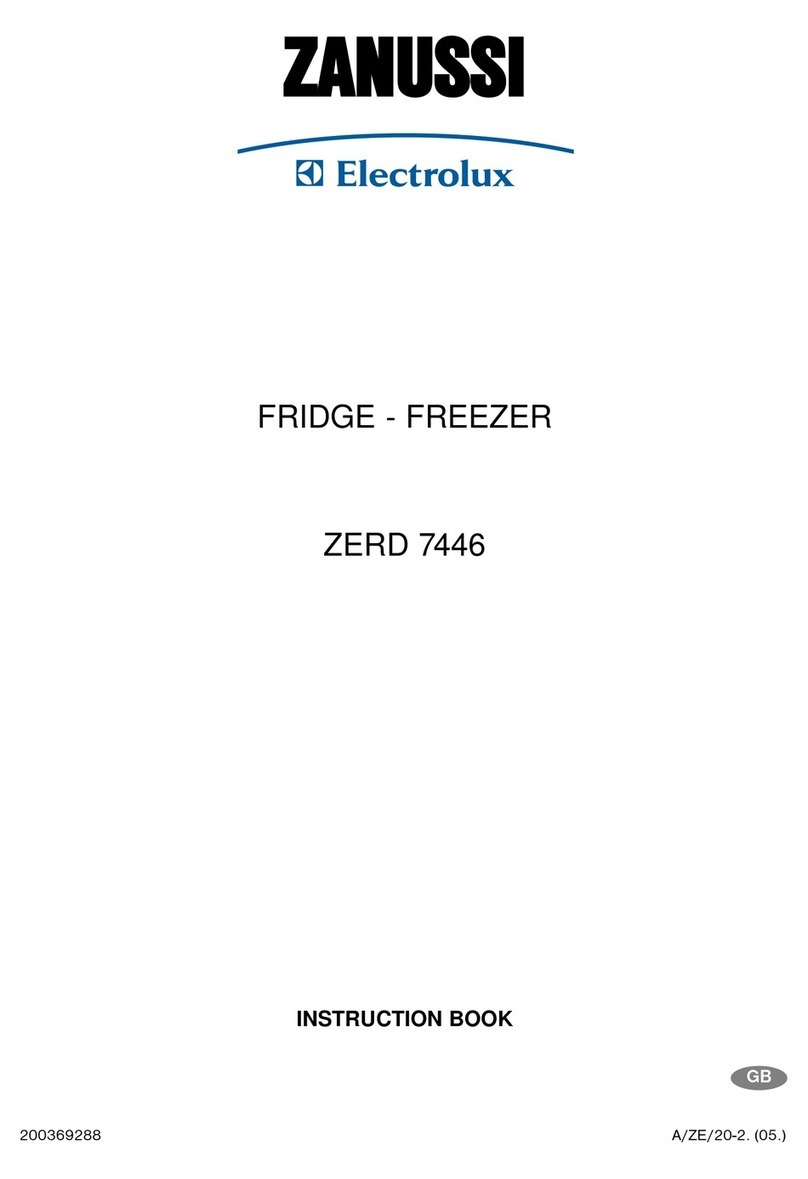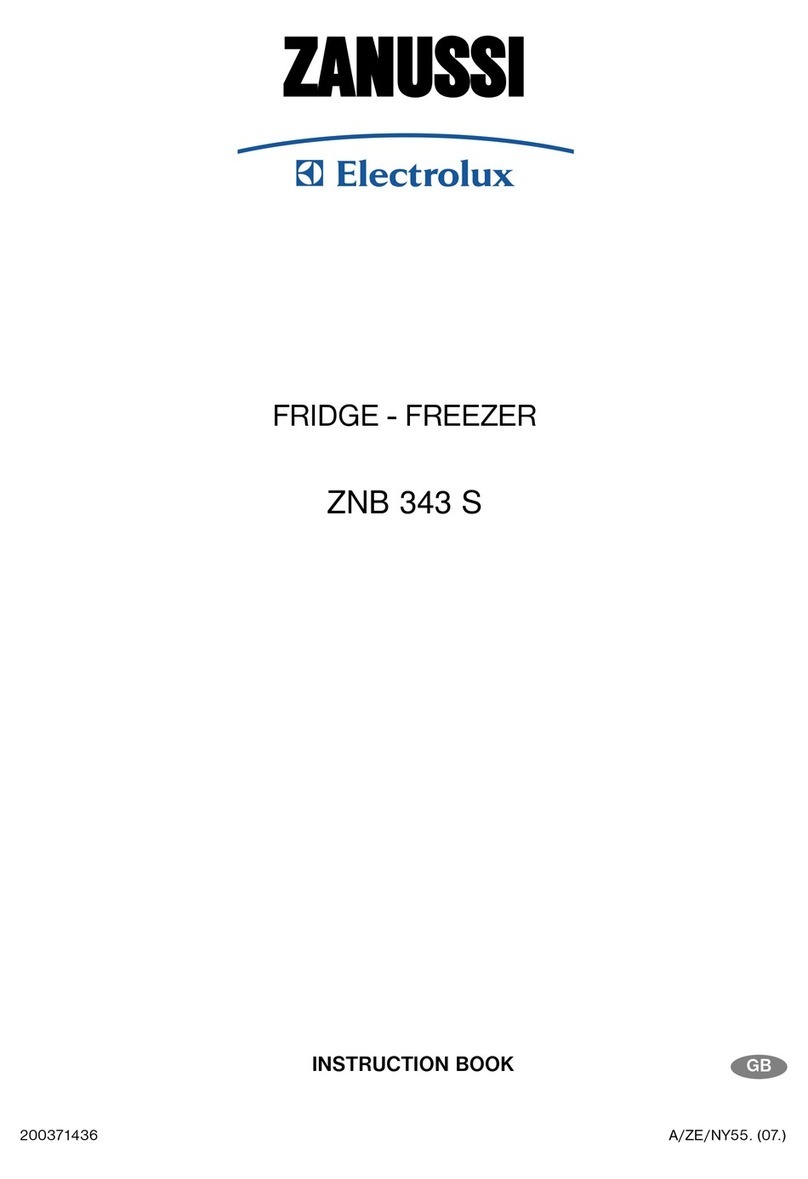7
• Keep the time bet een buying chilled food and
placing it in your fridge as short as possible. Tests
sho ed that the temperature of 1 litre of orange
juice rose to 22°C in an hour bet een the
supermarket and home. It then took 11 hours to
get do n to 7°C in the refrigerator.
• Keep the refrigerator door closed as much as
possible.
• Do not push food together too much, try to allo
air to circulate around each item.
• Cool cooked food as quickly as possible but do
NOT place in the refrigerator until cool. (Leave
food in a cool place in order that it can then be
placed in the refrigerator as soon as possible).
• Do NOT mix ra and cooked meat, they must be
in separate containers. Take care not to let the
meat juices drip onto other food. If the meat does
drip, remove everything and clean thoroughly.
• Do not store food uncovered.
• The best ay to defrost food is to put it in the
refrigerator to tha slo ly.
• Remove suspect food from your refrigerator and
clean (refer to “Maintenance and Cleaning).
• Never allo spillages to dry and harden.
• Ensure that food placed in the freezer is dated
and labelled and used in date order to ensure
that food is consumed at its best.
• It is important that food is used before its “best
before” date.
• Store eggs in the egg rack provided in the
refrigerator door. Discard any broken or chipped
eggs.
• Regularly check the refrigerator door seal to
ensure that it is clean and free from debris.
• Al ays ash your hands ith soapy ater and
dry them ith a clean to el before handling food.
• Keep ork surfaces clean and avoid cross
contamination by not using the same ork
surface or knife, ithout ashing them thoroughly
in bet een.
• The fresh foods to be frozen must be fresh and of
the best quality.
• The size of each pack should be small enough to
ensure that it is used in one go. Small packs
freeze more quickly and uniformly and give better
results.
• Frozen food, once tha ed, must not be refrozen.
Lean food keeps better and longer than fatty food,
salt reduces the storage time.
• Wrap the food in polythene or aluminium freezing
bags or foil so that they adhere to the food and
provide an airtight seal.
• Packaging hich is s ollen or has traces of
refrozen ater droplets on the pack could indicate
that the product has not been kept at a suitable
temperature and that it may have lost its original
quality. Partially tha ed food must not be
refrozen, it must be consumed ithin 24 hours.
Never exceed the storage times indicated.
• Never place bottles or cans of fizzy drink in the
freezer as they may explode. Containers ith a lid
must not be filled to the brim.
• Do not open the door or place extra fresh food in
the freezer next to food hich is already frozen as
this could cause the temperature of the frozen
food to rise and its quality and storage life to
reduce.
• The symbols on the dra ers sho different types
of frozen goods.
The numbers indicate storage times in months for
the appropriate types of frozen goods. Whether
the upper or lo er value of the indicated storage
time is valid depends on the quality of the foods
and pre-treating before freezing.
HEALTH AND SAFETY GUIDELINES
Because o consumer demand, preservatives have been removed rom many pre-prepared oods. This
together with the changes in shopping habits to a once-a-week shop, mean that sa e handling and
storage o ood is even more important than ever.
The ollowing tips should help you to ensure that the ood in your home is in as per ect condition as
possible.
14
INSTALLATION
Positioning
This appliance should only be installed at a location
here the ambient temperature corresponds to the
climate classification indicated on the rating plate,
hich is located at the left on the inside of the
appliance.
The follo ing table sho s hich ambient
temperature is correct for each climate classification:
SN +10°C to + 32°C
N +16°C to + 32°C
ST +18°C to + 38°C
T +18°C to + 43°C
It should be located in a dry atmosphere, out of
direct sunlight and a ay from extreme temperature
e.g. not next to a boiler or radiator, or in a very cold
room e.g. an outhouse, here the temperatures may
fall belo 10°C (50°F). If these temperatures are
exceeded i.e. colder or armer, then the appliance
may not operate correctly.
You should also ensure that air can circulate freely
around the back and the top of the cabinet. There
must also be at least 100 mm (4”) distance bet een
the top of the cabinet and any overhanging kitchen
furniture (A). Ideally, the appliance should not be
positioned beneath overhanging furniture (B).
There should also be a gap of 25 mm either side of
the appliance. Do not obstruct the space
underneath. The back of the cabinet may be placed
close to the all but must not touch it. DO NOT
install in places ith restricted ventilation.
Adjust the level of the appliance by scre ing out the
adjustable foot, or feet, at the bottom of the cabinet
using your fingers or a tool (see figure).
Warning
IF YOU ARE DISCARDING AN OLD APPLIANCE
THAT HAS A LOCK OR CATCH ON THE DOOR,
YOU MUST ENSURE THAT IT IS MADE
UNUSABLE TO PREVENT YOUNG CHILDREN
BEING TRAPPED INSIDE.
Important
It must be possible to disconnect the appliance from
the mains po er supply; the plug must therefore be
easily accessible after installation.
Rear spacers
The plastic bag containing all relevant
documentation also contains t o spacers to be fitted
into special holes in the back of the appliance.
Fit the spacers into the holes, taking care to ensure
that the arro (A) is positioned as sho n in the
diagram. Then turn them through 45° (arro (A)
vertical) until they lock into place.




